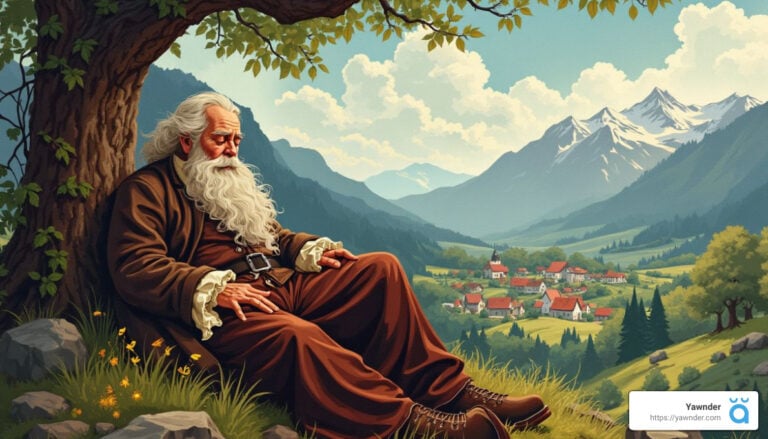Everything You Need to Know About the Meaning of the Rip Van Winkle Story
Understanding the Meaning of Rip Van Winkle
Washington Irving’s short story “Rip Van Winkle” transcends its surface narrative of a man who sleeps for two decades. Instead, it delves into a rich landscape of allegory and symbolism, effectively mirroring the profound transformations in American society during the era surrounding the American Revolutionary War. In this exploration, we will uncover the intricate layers of meaning behind the meaning of the Rip Van Winkle story.
Key Insights into the Story’s Meaning
1. Rip Van Winkle’s Long Sleep: His slumber serves as a poignant metaphor for the American colonies’ apathy before the Revolution.
2. Waking Up to Change: Rip’s awakening symbolizes the emergence of a new, independent national identity in post-Revolution America.
3. Dame Van Winkle as a Symbol: The domineering figure of Dame Van Winkle is often interpreted as an emblem of British oppression.
As a literature enthusiast with a background in library sciences, I find it crucial to unravel the multi-faceted themes embedded in the meaning of the Rip Van Winkle story. Let’s embark on a deeper analysis of this fascinating narrative.
The Story of Rip Van Winkle
Rip Van Winkle’s Character
Rip Van Winkle embodies the quintessential amiable farmer living in a Dutch-American village nestled at the foot of New York’s picturesque Catskill Mountains. Renowned for his affable spirit, Rip is often more absorbed in helping others than tending to his own farm. This inclination often leads to conflicts with his wife, Dame Van Winkle, whose persistent nagging pushes him to escape into the wild.
Key Events in the Tale
Rip, seeking solitude from his wife, wanders into the mountains. There, a peculiar encounter awaits him—a man dressed in vintage Dutch attire carrying a keg. Rip assists him, only to find himself among a group of strangely dressed men engrossed in a game of nine-pins, their raucous laughter echoing through the hills. Sipping from the keg, Rip soon succumbs to a deep drunken slumber.
When Rip eventually rouses, he discovers he has been asleep for twenty years. His physical transformation—long gray beard, rusty musket—is overshadowed by the drastic shifts in his village. The familiar sights have morphed; the village thrives with new faces, and discussions revolve around democracy and new governance rather than the lethargic converse of yesteryears.
His wife’s passing brings him an unexpected sense of relief, underscoring his newfound freedom. As he learns, the American Revolutionary War transpired during his sleep, altering the very fabric of his life and society.
The Profound Changes in Rip’s Village
Upon returning, Rip witnesses transformative changes:
– The old inn, once a focal point of his existence, has been replaced by the bustling Union Inn.
– Where King George III used to grace the walls, now hangs a portrait of George Washington.
– Conversations are vibrant with themes of elections and civil liberties, marking a stark contrast to the complacent discussions of his former life.
His daughter recognizes him, allowing Rip to transition into a revered town elder, sharing tales of yore with enthusiastic listeners.
The Central Themes and Symbolism
Rip Van Winkle as America’s Allegory
Rip illustrates the spirit of America—initially disinterested in governance, much like the colonies before the Revolution. His neglected home symbolizes British control over American life. Upon awakening, Rip finds a transformed landscape, akin to how America morphed into an independent nation. His new involvement in democratic processes reflects the colonies’ engagement in self-governance following liberation.
Dame Van Winkle as British Oppression
Dame Van Winkle epitomizes the constraints imposed by British rule. Her incessant nagging reflects the grip Britain had over the colonies. Her death during Rip’s slumber signifies the dissolution of British authority, paralleling America’s emergence into independence.
Rip’s relief at Dame Van Winkle’s demise metaphorically echoes the American colonies’ exhilaration upon liberating themselves from British oppression.
Themes of Change and Progress
At its core, Rip Van Winkle is a narrative saturated with themes emphasizing change and progress. Rip’s extensive sleep acts as a metaphorical time capsule, underscoring how life persists regardless of personal inertia.
– Old vs. New: The transformation of the inn demonstrates society’s progression and the rebirth of the nation.
– The New Leadership: The shift from the portrait of King George to that of George Washington parallels the transition towards sovereign governance.
The narrative teaches an essential lesson: while change may be disconcerting, it often ushers in opportunities for growth.
Overcoming Tyranny
A pivotal theme in the story is overcoming oppression. Rip’s reprieve from Dame Van Winkle symbolizes the American colonies’ struggle against tyranny. The villagers’ rebellion during Rip’s absence further encapsulates the fight for freedom.
Valuing Wisdom Over Labor
Rip’s character illustrates the idea that worth is not solely derived from labor. Rather than being condemned for idleness, he is celebrated for his wisdom and experiences as a town elder, challenging traditional notions of productivity.
The Intersection of History and Narration
Irving intricately weaves history with fiction, prompting readers to consider the reliability of narratives. This technique underscores the notion that history is often colored by interpretation and storytelling.
Cultural and Historical Context
The setting of Rip Van Winkle aligns with the upheaval of the American Revolutionary War, illuminating the psychological and practical adjustments faced by American citizens post-independence. Rip’s experiences resonate with the larger cultural shift toward democracy and self-identity, emphasizing a collective journey toward freedom and happiness.
Conclusion
In conclusion, the meaning of the Rip Van Winkle story reveals profound allegorical insights into America’s journey from colonialism to independence. Rip’s character embodies the nation’s evolution, while Dame Van Winkle represents British subjugation. The tale artfully underscores themes of change, freedom, and the perpetual flow of life.
Washington Irving’s narrative serves as a timeless reminder of the importance of adaptation and resilience in the face of transformation—lessons that resonate deeply with contemporaneous readers, much like the optimism inherent in Rip Van Winkle’s awakening.



















